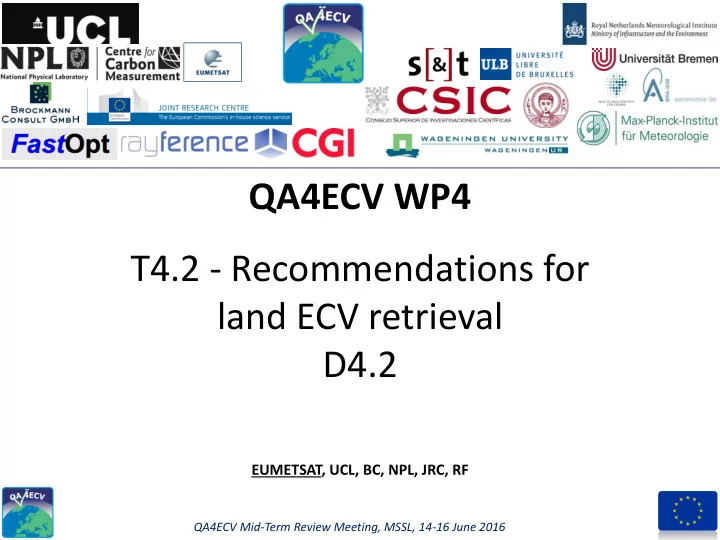

QA4ECV WP4 T4.2 - Recommendations for land ECV retrieval D4.2 EUMETSAT, UCL, BC, NPL, JRC, RF QA4ECV Mid-Term Review Meeting, MSSL, 14-16 June 2016
T4.2 Recommendations on Land ECV(1) Sensors/datasets considered for the BRDF/Albedo retrieval GlobAlbedo heritage: MERIS L1b SPOT-VGT L1P New LEO sensors: AVHRR LTDR MODIS Aqua/Terra SDR (MOD09GA/MYD09GA) Proba-V L1b (A)ATSR(2) New GEO sensors: Meteosat MVIRI/SEVIRI QA4ECV Mid-Term Review Meeting, MSSL, 14-16 June 2016
T4.2 Recommendations on Land ECV(1) AATSR data as candidate for ingestion as there were well known geolocation issues in previous AATSR datasets, an assessment study is required to check if ingestion of AATSR data in BRDF/albedo retrieval improves, does not change, or even degrades the quality of the inversion applied in the algorithm In order to measure the impact of the inclusion of AATSR data on the BRDF model inversion, three different processing modes were applied: caseA : only MERIS and VGT were used caseB : only AATSR nadir-view, MERIS and VGT caseC : all samples from AATSR, forward and nadir view, MERIS and VGT this study was performed by Gerardo Lopez for the previous AATSR reprocessing version. He found that the use of AATSR even degrades the quality of the inversion . We repeated Gerardo’s study (MODIS tile h25v06, 16-day period of BBDR input data in 2005), but with the modifications: use AATSR input from the latest reprocessing version, pre- process with a coregistration scheme proposed by Dan Fisher (King’s College London) QA4ECV Mid-Term Review Meeting, MSSL, 14-16 June 2016
T4.2 Recommendations on Land ECV(1) AATSR data as candidate for ingestion as an estimate of the model parameters derived from the three different cases were used to calculate the ‘goodness of fit’, which is basically a chi-square test. This measure describes how well it fits a set of observations, with values closer to zero indicating that the model fits better to the observation set: Results: see histograms below showing: Goodness_of_Fit for caseA difference of Goodness_of_Fit for caseB – caseA difference of Goodness_of_Fit for caseC - caseA QA4ECV Mid-Term Review Meeting, MSSL, 14-16 June 2016
T4.2 Recommendations on Land ECV(1) AATSR data as candidate for ingestion Goodness_of_Fit for caseA QA4ECV Mid-Term Review Meeting, MSSL, 14-16 June 2016
T4.2 Recommendations on Land ECV(1) AATSR data as candidate for ingestion difference of Goodness_of_Fit for caseB - caseA QA4ECV Mid-Term Review Meeting, MSSL, 14-16 June 2016
T4.2 Recommendations on Land ECV(1) AATSR data as candidate for ingestion difference of Goodness_of_Fit for caseC - caseA QA4ECV Mid-Term Review Meeting, MSSL, 14-16 June 2016
T4.2 Recommendations on Land ECV(1) AATSR data as candidate for ingestion Conclusions: The best goodness of fit is found for ‘caseA’ when using only MERIS and VGT data for the BRDF model inversion the decrease in inversion quality seems to be less serious as for non-coregistered input, but is still visible gof_diff_caseB_caseA shows now a more or less symmetric histogram (mean value just slightly positive, ~ 2.0), indicating that ingestion of coregistered AATSR nadir has not much influence on inversion quality gof_diff_caseC_caseA still shows an asymmetric histogram towards positive values (i.e. between +25 and +50, mean value ~ 7.0). Although not as obvious as for the non-coregistered data, ingestion of AATSR nadir and forward still seems to decrease inversion quality Suggestion: Add AATSR to the retrieval, but only Nadir view and only period 1998-2002 when no MERIS data are available QA4ECV Mid-Term Review Meeting, MSSL, 14-16 June 2016
Recommend
More recommend